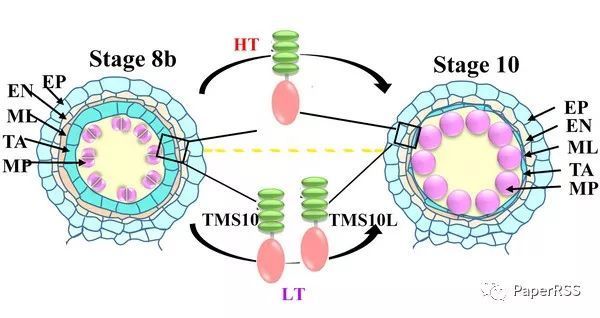《上海交通大学学报》
PNAS|上海交大团队研究水稻温敏雄性不育机制获重
来源:上海交通大学学报 【在线投稿】 栏目:综合新闻 时间:2020-10-29:2017年10月27日,国际著名学术期刊《美国科学院院刊》在线发表了上海交通大学生命科学技术学院张大兵教授课题组的最新研究成果“Two rice receptor-like kinases maintain male fertility under changing temperatures”。
2017年10月27日,国际著名学术期刊《美国科学院院刊》在线发表了上海交通大学生命科学技术学院张大兵教授课题组的最新研究成果“Two rice receptor-like kinases maintain male fertility under changing temperatures”。该项研究克隆了一个新的水稻温敏雄性不育基因TMS10,tms10突变体高温不育,低温可育。

水稻是世界上主要的粮食作物之一,在生产上主要有三系杂交水稻和两系杂交水稻之分。近年来,两系不育系因配组自由等优点大大促进了两系杂交稻在生产中应用和推广。但是,目前生产中使用的不育系主要为温(光)敏型不育系,基因来源主要为安农S-1和陪矮64S,育性转换受表观遗传调控,易出现不育起点温度向上漂移的现象。因此,挖掘新的温(光)敏雄性不育调控基因资源在两系杂交育种中具有重要的应用价值。张大兵研究团队十几年来致力于水稻生殖发育的调控网络研究,在水稻光/温敏雄性不育调控机制方面开展了系列研究,于2010年《Plant Cell》研究发现MYB转录因子CSA调节水稻花药中糖的分配,2012年在《PNAS》报道csa突变体表现出短日可育,长日不育,为光敏不育系材料的开发和应用提供了新的基因资源。
在研究中,张大兵研究团队发现水稻tms10突变体表现出高温雄性不育,低温雄性可育的表型,育性转换临界点温度为22-24℃。细胞学分析和基因克隆发现,TMS10编码一个亮氨酸受体激酶,高温条件下TMS10激酶活性在水稻花药绒毡层的降解过程中起重要作用,而在tms10突变体中绒毡层不能正常降解导致花药外壁发育异常。机理研究发现TMS10及其同源基因TMS10L冗余的调控水稻花药发育,tms10 tms10l双突变高低温下均表现出雄性不育,暗示TMS10基因特异的在高温条件下调控水稻花药的发育。

图 1 tms10表现出温敏雄性不育表型

图 2TMS10基因的鉴定,定位,进化分析
该研究还利用CRISPR-Cas9基因编辑技术和传统的杂交转育方法分别在粳稻和籼稻中获得tms10纯合突变体,所有不育系均表现出高温不育,低温可育的表型,表明TMS10在粳稻和籼稻中功能是保守的,为进一步在生产中应用该基因位点,研发新的温(光)敏型不育系材料和两系杂交生产奠定了基础。

Two rice receptor-like kinases maintain male fertility under changing temperatures
PNAS ( IF 9.661 )Pub Date : 2017-10-30,DOI: 10.1073/pnas.
Junping Yu, Jiaojiao Han, Yu-Jin Kim, Ming Song, Zhen Yang, Yi He, Ruifeng Fu, Zhijing Luo, Jianping Hu, Wanqi Liang, Dabing Zhang
doi:10.1073/pnas.
Abstract:
Plants employ dynamic molecular networks to control development in response to environmental changes, yet the underlying mechanisms are largely unknown. Here we report the identification of two rice leucine-rich repeat receptor-like kinases, Thermo-Sensitive Genic Male Sterile 10 (TMS10) and its close homolog TMS10-Like (TMS10L), which redundantly function in the maintenance of the tapetal cell layer and microspore/pollen viability under normal temperature conditions with TMS10 playing an essential role in higher temperatures (namely, 28 °C). tms10 displays male sterility under high temperatures but male fertility under low temperatures, and the tms10 tms10ldouble mutant shows complete male sterility under both high and low temperatures. Biochemical and genetic assays indicate that the kinase activity conferred by the intracellular domain of TMS10 is essential for tapetal degeneration and male fertility under high temperatures. Furthermore, indica or japonica rice varieties that contain mutations in TMS10, created by genetic crosses or genome editing, also exhibit thermo-sensitive genic male sterility. These findings demonstrate that TMS10 and TMS10L act as a key switch in postmeiotic tapetal development and pollen development by buffering environmental temperature changes, providing insights into the molecular mechanisms by which plants develop phenotypic plasticity via genotype–environment temperature interaction. TMS10 may be used as a genetic resource for the development of hybrid seed production systems in crops.
